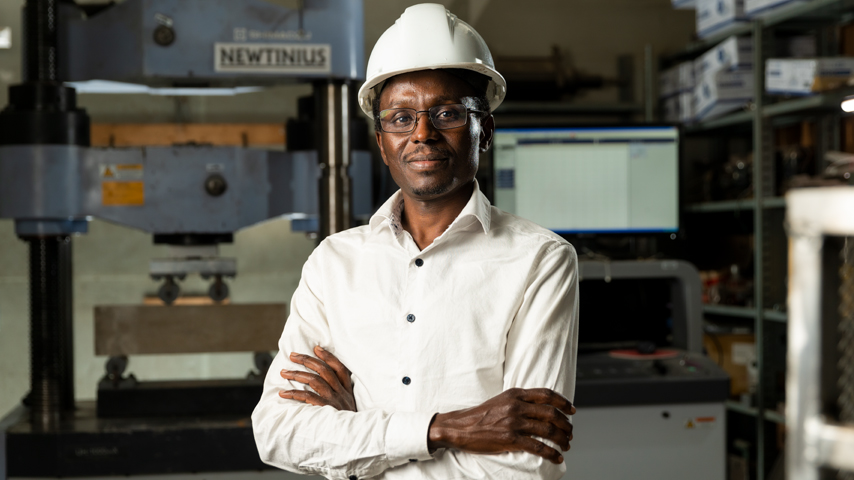https://www.asme.org/topics-resources/content/designing-better-concrete-for-smrs
Designing Better Concrete for SMRs
Researcher Ousmane Hisseine and colleagues are developing a stronger, denser material that can protect small modular reactors and the engineers who work on them.
Share on LinkedIn Share on Twitter Share on Facebook Share via email
Date Published:
Jan 9, 2024
Author:
Kayt Sukel
Tags:
Building Construction Electric Power Energy Utility System Construction
Image Credit:
McMaster University
Collection:
Energy Transformation Collection
Nuclear power has the potential to generate billions of kilowatt hours of electricity and do so without harmful greenhouse gas emissions. That promise has generated interest across the world and many countries are investing in new nuclear energy applications.
Today, countries like Canada, which struggle to supply power to remote areas in northern regions, are looking toward small modular reactors (SMRs), advanced nuclear reactors that can produce a large amount of low-carbon electricity. Such reactors require a smaller initial capital investment and can be deployed to a wide range of different sites, while their modular nature provides the opportunity for greater scalability by easily adding new reactors to the same power plant.
“These reactors are smaller in capacity and size than traditional nuclear reactors. They can be easily constructed in a modular process. The combination of the size and modularity make nuclear energy more affordable,” said Ousmane Hisseine, assistant professor of civil engineering at McMaster University in Hamilton, Ontario. “With the global drive toward decarbonization, these reactors can help move us toward cleaner energy.”
More on Advanced Nuclear Power: Nuclear Microreactor Nears Reality
Yet, it is imperative that engineers ensure nuclear reactors, even these SMRs, are safe for the communities they power. And that, Hisseine said, requires using the right materials to build both the SMRs and containment units for the waste they produce.
“Whenever anyone talks about nuclear energy, people’s first thoughts are about safety—and for good reason,” he said. “The majority of the physical infrastructure that provides safety to nuclear power plants relies on concrete. There is a significant need to create a better performing concrete that can address a variety of safety concerns.”
The dome that shelters a typical nuclear reactor is made of concrete and can be up to one meter thick. Nuclear waste is stored and transported in steel dry casks, which contain concrete inserts that are up to 75 centimeters thick to prevent the potentially hazardous contents from escaping.
“In comparison, the concrete wall we use in our homes is only about 20 centimeters thick,” Hisseine said. “We need the concrete in these domes and casks to be much thicker so we can capture the radiation inside and keep it from harming the plant workers or the outside environment.”
Hisseine and his colleagues are currently working on a new recipe for a novel concrete material specifically designed to improve safety in SMR nuclear facilities. The new material, called Damage-Tolerant Radiation-Shielding Ultra-High-Performance Concrete (DT-RS-UHPC), will be much stronger than typical concrete and will have a high energy absorption capacity.
Conventional concrete used for building has a strength measuring about 25-to-35 megapascals. The high-performance concrete used for bridges and other major infrastructure is stronger, in the 60-to-80 megapascal range. Hisseine’s goal is to create a new material with a strength of a whopping 120-to-150 megapascals.
“We want to double the strength of high-performance concrete so we can obtain higher resistance while remaining compact. We want to minimize any voids between ingredients to achieve higher radiation attenuation,” he explained. “With the right ingredients, we should also be able to achieve higher capacity, higher resistance, and higher durability to protect the concrete from radiation, damage, and deteriorative agents that may be outside the concrete containers.”
- Forums
- ASX - By Stock
- Could there be an advantage for EDE's pyrolysis in this?
https://www.asme.org/topics-resources/content/designing-better-co...
- There are more pages in this discussion • 3 more messages in this thread...
You’re viewing a single post only. To view the entire thread just sign in or Join Now (FREE)
Featured News
Add EDE (ASX) to my watchlist
 (20min delay) (20min delay)
|
|||||
|
Last
0.2¢ |
Change
0.000(0.00%) |
Mkt cap ! $7.357M | |||
| Open | High | Low | Value | Volume |
| 0.2¢ | 0.2¢ | 0.2¢ | $510 | 255K |
Buyers (Bids)
| No. | Vol. | Price($) |
|---|---|---|
| 69 | 211860033 | 0.1¢ |
Sellers (Offers)
| Price($) | Vol. | No. |
|---|---|---|
| 0.2¢ | 27301125 | 20 |
View Market Depth
| No. | Vol. | Price($) |
|---|---|---|
| 69 | 211860033 | 0.001 |
| 0 | 0 | 0.000 |
| 0 | 0 | 0.000 |
| 0 | 0 | 0.000 |
| 0 | 0 | 0.000 |
| Price($) | Vol. | No. |
|---|---|---|
| 0.002 | 27301125 | 20 |
| 0.003 | 28674313 | 27 |
| 0.004 | 11853426 | 11 |
| 0.005 | 271625 | 2 |
| 0.006 | 432510 | 4 |
| Last trade - 10.02am 16/05/2024 (20 minute delay) ? |
Featured News
| EDE (ASX) Chart |
The Watchlist
SS1
SUN SILVER LIMITED
Gerard O’Donovan, Executive Director
Gerard O’Donovan
Executive Director
SPONSORED BY The Market Online





